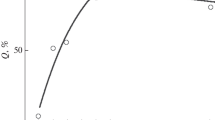Abstract
Schooling motion of fish was studied experimentally and analytically, focusing on two essential motions (approaching motion and parallel orienting motion) that fish execute to form and maintain a highly organized schooling motion. Two species of fish (bearded silverside, or Atherion elymus, and striped mullet, or Mugil cephalus) were observed, and the correlation of measured motion parameters (position, body direction, and moving direction) among individuals was used to determine which motion each individual was executing. Conspicuous similarities and differences between the approaching motion and parallel orienting motion were found in the number of interacting neighbors and in the relative position and time delay of motion between interacting individuals. An analytical model to simulate schooling motion was then designed based on those experimental results. The simulated schooling motion well reproduced the motion of a natural fish school and was therefore used to study the relationship between local interaction among individuals and global properties of schooling motion. This experimental and analytical approach both quantitatively and qualitatively clarified the properties of schooling motion of fish.
Access this chapter
Tax calculation will be finalised at checkout
Purchases are for personal use only
Preview
Unable to display preview. Download preview PDF.
Similar content being viewed by others
References
Aoki I (1982) A simulation study on the schooling mechanism in fish. Bull. Jap. Soc. Sci. Fish.48:1081–1088.
Breder C M (1959) Studies on the social groupings of fishes. Bull. of American Museum of Natural History 117(6):393–482
Gueron S, Levin S A., Rubenstein DI The Dynamics of Herds: From Individual to Aggregations. J. Theor. Biol. 182:85–98.
Huth A, Wissel C (1992) The simulation of the movement of fish schools. J. Theor. Biol. 156:365–385.
Huth A, Wissel C (1994) The simulation of fish schools in comparison with experimental data. Ecological modeling, 75/76: 135–145
Inada Y, Kawachi K (2002) Order and Flexibility in the Motion of Fish Schools. J. Theor. Biol. 214(3):371–387.
Matuda K, Liang Z, Sannomiya N. (1993) Comparison among fish species on parameters in fish behavior model. Proc. ICES Mar. Sci. Symp., 196, 103–107.
Niwa, H.-S (1996) Newtonian Dynamical Approach to Fish School. J. Theor. Biol. 181:47–63.
Okubo A (1980) The dynamics of animal groupings. In: Diffusion and Ecological Problems: Mathematical Models, Springer, Berlin, pp.110–131.
Okubo A (1986) Dynamical aspects of animal groupings, swarms, schools, flocks and herds. Adv. Biophys. 22:1–94.
Parrish J K, Edelstein-Keshet L (1999) Complexity, Pattern, and Evolutionary Trade-Offs in Animal Aggregation. Science 284:99–101.
Partridge B L (1982) The structure and function of fish schools. Scientific American June: 114–123.
Pitcher T J, Parrish J K (1993) Functions of shoaling behavior in teleosts. In: Pitcher T J (Ed) Behavior of Teleost Fishes, Chapman and Hall, London, pp 363–440.
Sakai S, Suzuki R (1973) A model for group structure and its behavior. Rep. Research Group on Medical Electronics and Biological Engineering No.MEB73–4:73–4. (in Japanese)
Sannomiya N (1999) Emergence of Cooperation in Fish Behavior Models. T.SICE 35(11): 1370–1376 (in Japanese).
Shaw E (1970) Schooling in fishes: critique and review. In: Aronson L. (Ed) Development and evolution of behavior, Freeman, San Francisco CA, pp. 452–480.
Author information
Authors and Affiliations
Editor information
Editors and Affiliations
Rights and permissions
Copyright information
© 2004 Springer Japan
About this paper
Cite this paper
Inada, Y., Kawachi, K., Liu, H. (2004). Experimental and Analytical Study of the Schooling Motion of Fish Based on Two Observed Individual Motions: Approaching Motion and Parallel Orienting Motion. In: Kato, N., Ayers, J., Morikawa, H. (eds) Bio-mechanisms of Swimming and Flying. Springer, Tokyo. https://doi.org/10.1007/978-4-431-53951-3_11
Download citation
DOI: https://doi.org/10.1007/978-4-431-53951-3_11
Publisher Name: Springer, Tokyo
Print ISBN: 978-4-431-67963-9
Online ISBN: 978-4-431-53951-3
eBook Packages: Springer Book Archive




